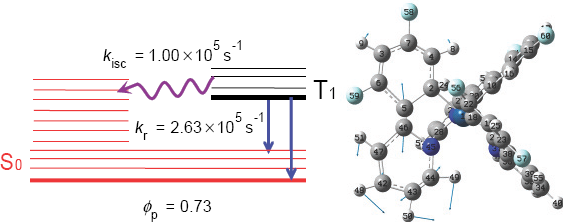| [1] Sun, Y.; Giebink, N. C.; Kanno, H.; Ma, B.; Thompson, M. E.; Forrest, S. R. Nature 2006, 440, 908. [2] Lamansky, S.; Djurovich, P.; Murphy, D.; Abdel-Razzaq, F.; Lee, H.; Adachi, C.; Burrows, P. E.; Forrest, S. R.; Thompson, M. E. J. Am. Chem. Soc. 2001, 123(18), 4304. [3] Kwong, R. C.; Nugent, M. R.; Michalski, L.; Ngo, T.; Rajan, K.; Tung, Y.; Weaver, M. S.; Zhou, T. X.; Hack, M.; Thompson, M. E.; Forrest, S. R.; Brown, J. J. Appl. Phys. Lett. 2002, 81(1), 162. [4] Tokito, S.; Iijima, T.; Tsuzuki, T.; Sato, F. Appl. Phys. Lett. 2003, 83(12), 2459. [5] Tsuboyama, A.; Iwawaki, H.; Furugori, M.; Mukaide, T.; Kamatani, J.; Igawa, S.; Moriyama, T.; Miura, S.; Takiguchi, T.; Okada, S.; Hoshino, M.; Ueno, K. J. Am. Chem. Soc. 2003, 125(42), 12971. [6] Baldo, M. A.; O'Brien, D. F.; You, Y.; Shoustikov, A.; Sibley, S.; Thompson, M. E.; Forrest, S. R. Nature 1998, 395(6698), 151. [7] Sajoto, T.; Djurovich, P. I.; Tamayo, A. B.; Oxgaard, J.; Goddard, W. A.; Thompson, M. E. J. Am. Chem. Soc. 2009, 131(28), 9813. [8] Endo, A.; Suzuki, K.; Yoshihara, T.; Tobita, S.; Yahiro, M.; Adachi, C. Chem. Phys. Lett. 2008, 460(1~3), 155. [9] Wang, L. X.; Mei, Q. B.; Yan, F.; Tian, B.; Weng, J. N.; Zhang, B.; Huang, W. Acta Phys.-Chim. Sin. 2012, 28(7), 1556. (王玲霞, 梅群波, 颜芳, 田波, 翁洁娜, 张彬, 黄维, 物理化学学报, 2012, 28(7), 1556.) [10] Tao, R.; Qiao, J.; Duan, L.; Qiu, Y. Prog. Chem. 2010, 22(12), 2255. (陶然, 乔娟, 段炼, 邱勇, 化学进展, 2010, 22(12), 2255.) [11] Jansson, E.; Minaev, B.; Schrader, S.; Ågren, H. Chem. Phys. 2007, 333(2~3), 157. [12] Peng, Q.; Niu, Y.; Shi, Q.; Gao, X.; Shuai, Z. J. Chem. Theory Comput. 2013, 9(2), 1132. [13] Jiang, Y. Q.; Peng, Q.; Gao, X.; Shuai, Z. G.; Niu, Y. L.; Lin, S. H. J. Mater. Chem. 2012, 22, 4491. [14] Tamayo, A. B.; Alleyne, B. D.; Djurovich, P. I.; Lamansky, S.; Tsyba, I.; Ho, N. N.; Bau, R.; Thompson, M. E. J. Am. Chem. Soc. 2003, 125(24), 7377. [15] Dedeian, K.; Shi, J.; Shepherd, N.; Forsythe, E.; Morton, D. C. Inorg. Chem. 2005, 44(13), 4445. [16] Park, N. G.; Choi, G. C.; Lee, Y. H.; Kim, Y. S. Curr. Appl. Phys. 2006, 6(4), 620. [17] Lin, S. H.; Chang, C. H.; Liang, K. K.; Chang, R.; Shiu, Y. J.; Zhang, J. M.; Yang, T. S.; Hayashi, M.; Hsu, F. C. Adv. Chem. Phys. 2002, 1. [18] Niu, Y.; Peng, Q.; Deng, C.; Gao, X.; Shuai, Z. J. Phys. Chem. A 2010, 114(30), 7817. [19] Ianconescu, R.; Pollak, E. J. Phys. Chem. A 2004, 108(39), 7778. [21] Dalton, a molecular electronic structure program, Release Dalton2011 (2011), see http://daltonprogram.org. [22] Minaev, B.; Ågren, H. Chem. Phys. 2005, 315(3), 215. [23] Vahtras, O.; Ågren, H.; Jorgensen, P.; Jensen, H. J. A.; Helgaker, T.; Olsen, J. J. Chem. Phys. 1992, 97(12), 9178. [24] Koseki, S.; Fedorov, D. G.; Schmidt, M. W.; Gordon, M. S. J. Phys. Chem. A 2001, 105(35), 8262. [25] Koseki, S.; Schmidt, M. W.; Gordon, M. S. J. Phys. Chem. A 1998, 102(50), 10430. [26] Li, X.; Minaev, B.; Ågren, H.; Tian, H. J. Phys. Chem. C 2011, 115(42), 20724. [27] Minaev, B.; Ågren, H.; Angelis, F. D. Chem. Phys. 2009, 358(3), 245. [28] Minaev, B.; Minaeva, V.; Ågren, H. J. Phys. Chem. A 2009, 113(4), 726. [29] Li, X.; Minaev, B.; Ågren, H.; Tian, H. Eur. J. Inorg. Chem. 2011, 2011(16), 2517. [30] Yersin, H.; Finkenzeller, W. J. In Highly Efficient OLEDs with Phosphorescent Materials, Ed.: Yersin, H., Wiley-VCH Verlag GmbH & Co. KgaA, Weiheim, Germany, 2008, pp. 1~98. |
